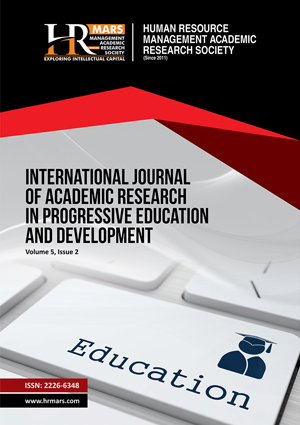
ISSN: 2226-6348
Open access
This study aims to examine the factors affecting behavioural intention to use video-based learning among higher education’s students. The study used technology of acceptance model (TAM) to identify the factors that predict intention to use video-based learning. These study used a cross-sectional quantitative study design involving 243 university students. The data was collected using an online survey due to the COVID-19 restrictions. The proposed hypotheses were analysed using correlation and multiple linear regression. Results of this research revealed that perceived ease of use and perceived usefulness have a significant effect on the intention to use video based learning. The practical implications inform policymakers and educational institutions on how video-based adoption can be enhanced. In this context, perceived ease of use and perceived usefulness are identified as predictors of intention to use video-based learning among higher education’s students.
Adedoyin, O. A., & Soykan, E. (2020) Covid-19 pandemic and online learning: the challenges and opportunities, Interactive Learning Environments, 1-13. https://doi.org/10.1080/10494820.2020.1813180
Abdullah, F., & Ward, R. (2016). Developing a General Extended Technology Acceptance Model for E-Learning (GETAMEL) by analysing commonly used external factors. Computers in Human Behavior, 56, 238–256. https://doi.org/10.1016/j.chb.2015.11.036
Alyoussef, I. Y. (2021). E-Learning Acceptance: The Role of Task–Technology Fit as Sustainability in Higher Education. Sustainability, 13, 6450. https://doi.org/ 10.3390/su13116450
Beaunoyer, E., Dupere, S., & Guitton, M. J. (2020). COVID-19 and digital inequalities: Reciprocal impacts and mitigation strategies. Computers in Human Behavior, 111, 106424. https://doi.org/10.1016/j.chb.2020.106424
Chaveesuk, S., Wutthirong, P., & Chaiyasoonthorn, W. (2018). Cloud computing classroom acceptance model in Thailand higher education’s institutes: A conceptual framework. ACM International Conference Proceeding Series, 141–145. https://doi.org/10.1145/3285957.3285989
Davis, F. D. (1989). Perceived usefulness, perceived ease of use, and user acceptance of information technology. MIS Quarterly, 13(3), 319-340
Dick, W., Carey, L., & Carey, J. O. (2014). Systematic Design of Instruction, The (8th ed.). Pearson.
Estriegana, R., Medina-Merodio, J. A., & Barchino, R. (2019). Student acceptance of virtual laboratory and practical work: An extension of the technology acceptance model. Computers & Education, 135, 1–14. https://doi. org/10.1016/j.compedu.2019.02.010
Foroughi, B., Iranmanesh, M., & Hyun, S. S. (2019). Understanding the determinants of mobile banking continuance usage intention. Journal of Enterprise Information Management, 32(6), 1015–1033. https://doi.org/10.1108/JEIM-10-2018-0237
Galatsopoulou, F., Kenterelidou, C., Kotsakis, R., Matsiola, M. (2022). Examining Students’ Perceptions towards Video-Based and Video-Assisted Active Learning Scenarios in Journalism and Communication Courses. Educ. Sci, 12, 74. https://doi.org/ 10.3390/educsci12020074
Habibi, A., Khaeruddin, K., Indrayana, B., Syahruddin, S., Makadada, F. A., & Hakim, H. (2020). Using an extended Technology Acceptance Model to understand students’ use of e-learning during Covid-19: Indonesian sport science education context. Heliyon, 6(11), e05410. https://doi.org/10.1016/j.heliyon.2020.e05410
Hair, J. F., Black, W. C., Babin, J. E., & Anderson, R. E. (2019). Multivariate Data Analysis (Ed. 7th). Cengage Learning: Hamsphire.
McEvoy, C. S., Cantore, K. M., Denlinger, L. N., Schleich, M. A., Stevens, N. M., Swavely, S. C., Odom, A. A., & Novick, M. B. (2016). Use of medical students in a flipped classroom programme in nutrition education for fourth-grade school students. Health Education Journal, 75(1), 38–46.
https://doi.org/10.1177/0017896914561879
Mikalef, P., Pappas, I. O., & Giannakos, M. N. (2016). Investigating determinants of video-based learning acceptance BT - state-of-the-art and future directions of smart learning (Y. Li, M. Chang, M. Kravcik, E. Popescu, R. Huang, Kinshuk, & N.-S. Chen, eds). Springer Singapore. 483–491
Muthuprasad, T., Aiswarya, S., Aditya, K. S., & Jha, G. K. (2021). Social Sciences & Humanities Open Students ’ perception and preference for online education in India during COVID -19 pandemic. Social Sciences & Humanities Open, 3(1), 100101. https://doi.org/10.1016/j.ssaho.2020.100101
Morrison, G. R., Ross, S., Morrison, J. R., & Kalman, H. K. (2019). Designing effective instruction. John Wiley & Sons, Inc: Hoboken,NJ.
Pal, D., & Patra, S. (2021). University Students’ Perception of Video-Based Learning in Times of COVID-19: A TAM/TTF Perspective, International Journal of Human–Computer Interaction, 37(10), 903-921. https://doi.org/ 10.1080/10447318.2020.1848164
Pokhrel, S., and Chhetri, R. (2021). A Literature Review on Impact of COVID-19 Pandemic on Teaching and Learning. Higher Education for the Future, 8(1), 133-141.
Shahzad, A., Hassan, R., Aremu, A., Hussain, A. and Lodhi, R., 2020. Effects of COVID-19 in E-learning on higher education institution students: the group comparison between male and female. Quality & Quantity, 55(3), 805-826.
Sintema, E. J. (2020). Effect of COVID-19 on the Performance of Grade 12 Students Implications for STEM. Education. Eurasia Journal of Mathematics, Science and Technology Education, 16 (7), 1-6. https://doi.org/10.29333/ejmste/7893
Tarhini, M. E. A. (2017). Factors affecting the adoption of e-learning systems in Qatar and USA?: Extending the Unified Theory. Educational Technology Research and Development. https://doi.org/10.1007/s11423-016-9508-8
Turan, Z., & Cetintas, H. B. (2020). Investigating university students’ adoption of video lessons. Open Learning, 35(2), 122–139. https://doi.org/10.1080/02680513.2019.1691518
Zhu, X., & Liu, J. (2020). Education in and After Covid-19: Immediate Responses and Long-Term Visions. Postdigital Science and Education, 2(3), 695–699. https://doi.org/10.1007/s42438-020-00126-3
In-Text Citation: (Said et al., 2022)
To Cite this Article: Said, C. S., Jelani, A. B., Rashid, N. A., Kamarulzaman, M. A., Rahman, M. H. A., Ismail, N., Noor, A. F. M., & Amin, J. M. (2022). Exploring University Students’ Acceptance in Online Learning Using Technology Acceptance Model (TAM). International Journal of Academic Research in Progressive Education and Development, 11(4), 81–89.
Copyright: © 2022 The Author(s)
Published by Human Resource Management Academic Research Society (www.hrmars.com)
This article is published under the Creative Commons Attribution (CC BY 4.0) license. Anyone may reproduce, distribute, translate and create derivative works of this article (for both commercial and non-commercial purposes), subject to full attribution to the original publication and authors. The full terms of this license may be seen at: http://creativecommons.org/licences/by/4.0/legalcode